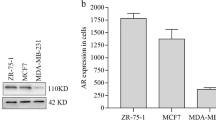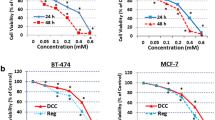Abstract
Antiandrogens have sporadically been reported to exert antitumor activities in both pre-and post-menopausal breast cancer. To explore the possibility of using the pure antiandrogen flutamide (FLU) in breast cancer therapy, rats bearing DMBA-induced mammary tumors were treated with FLU, dihydrotestosterone (DHT), or FLU plus DHT. FLU was administered orally, at doses comparable to those used in the treatment of prostate cancer patients. FLU-treated animals had a significantly smaller average tumor area than controls from day 11 up to the end of the experiment (day 20). A similar reduction of tumor growth was observed in rats given DHT and in those treated with DHT plus FLU. Plasma levels of LH, FSH, P, 17-OH P, E2 and DHEA measured at the end of experiment did not differ between treated animals and controls. Results demonstrate that the antiandrogen FLU and the full androgen DHT exert similar inhibitory effects on the growth of dimethylbenz(a)anthracene (DMBA)-induced rat mammary tumors. Moreover, data show that plasma steroids levels are unaffected by FLU treatment. This finding rules out any antitumor effect dependent on the reduction of adrenal and gonadal steroidosynthesis, and makes it appear more likely that androgen receptors are involved in the antiproliferative effect of FLU.
Similar content being viewed by others
Abbreviations
- AR:
-
Androgen receptors
- DHEA :
-
Dehydroepiandrosterone
- DHT :
-
Dihydrotestosterone
- DMBA :
-
7,12-Dimethylbenz(a)anthracene
- E 2 :
-
17β-Estradiol
- FLU :
-
Flutamide
- P :
-
Progesterone
- 17-OH P :
-
17-Hydroxy-progesterone
References
Asselin J, Labrie F (1977) Effects of estradiol and prolactin on steroid receptor levels in 7,12-dimethylbenz(a)anthracene-induced mammary tumors and uturus in the rat. J Steroid Biochem 9:1079–1082
Asselin J, Mélacon R, Moachon G, Bélanger A (1980) Characteristics of binding to estrogen, androgen, progestin and glucocorticoid receptors in 7,12-dimethylbenz(a)anthracene-induced mammary tumors and their hormonal control. Cancer Res 40:1612–1622
Ayub M, Levell M (1987) Inhibition of rat testicular 17-hydroxylase and 17,20-lyase activities by anti-androgens (flutamide, hydroxyflutamide, RU23908, cyproterone acetate) in vitro. J Steroid Biochem 28:43–47
Ayub M, Levell M (1990) Suppression of plasma androgens by the antiandrogen flutamide in prostatic cancer patients treated with Zoladex, a GnRH analogue. Clin Endocrinol 32:329–339
Balzano S, Cappa M, Migliari R, Scarpa R, Danielli E, Campus G, Pintus C, Sica V, Martino E (1988) The effect of flutamide on basal and ACTH-stimulated plasma levels of adrenal androgens in patients with advanced prostate cancer. J Endocrinol Invest 11:693–696
Benz C, Hollander C, Miller B (1986) Endocrine-responsive pancreatic carcinoma: steroid binding and cytotoxicity studies in human tumor cell lines. Cancer Res 46:2276–2281
Boccuzzi G, Brignardello E, Massobrio M, Bonino L (1987) Breast duct fluid dehydroepiandrosterone sulphate in fibrocystic disease. Eur J Cancer Clin Oncol 23:1099–1102
Brann D, Putnam C, Mahesh V (1990) Similarities and differences in progesterone and androgens in modulation of LH, FSH, and PRL release: unexpected properies of flutamide. J Steroid Biochem 36:287–294
Bretani M, Franco E, Oshima C, Pacheco M (1986) Androgen, estrogen and progesterone receptor levels in malignant and benign breast tumours: a multivariate analysis approach. Int J Cancer 38:637–640
Brogden R, Clissold S (1989) Flutamide: a preliminary review of its pharmacodynamic and pharmacokinetic properties and therapeutic efficacy in advanced prostatic cancer. Drugs 38:185–203
Brogden R, Chrisp P (1991) Flutamide: a review of its pharmacodynamic and pharmacokinetic properties and therapeutic use in advanced prostatic cancer. Drugs Aging 1:104–115
Bryan R, Mercer R, Bennet M, Rennie G, Lie T, Morgan F (1984) Androgen receptors in breast cancer. Cancer 54:2436–2439
Couzinet B, Pholsena M, Young J, Schaison G (1993) The impact of a pure anti-androgen (flutamide) on LH, FSH, androgens and clinical status in idiopathic hirsutism. Clin Endocrinol 39:157–162
Daneshgari F, Crawford D (1993) Endocrine therapy of advanced carcinoma of the prostate. Cancer 71:1089–1097
Dauvois S, Li S, Martel C, Labrie F (1989) Inhibitory effect of androgens on DMBA-induced mammary carcinoma in the rat. Breast Cancer Res Treat 14:299–306
Di Monaco M, Brignardello E, Leonardi L, Gatto V, Gallo M, Pizzini A, Boccuzzi G (1993) The antiandrogen flutamide inhibits growth of MCF-7 human breast cancer cell line. Int J Oncol 2:653–656
Doberauer C, Niederle N, Schmidt C (1988) Advanced male breast cancer treatment with the LHRH analogue buserelin alone or in combination with the antiandrogen flutamide. Cancer 62:474–478
Etreby M El, Habenicht U, Louton T, Nishino Y, Schroder H (1987) Effect of cyproterone acetate in comparison to flutamide and megestrol acetate on the ventral prostate, seminal vescicle and adrenal glands of adult male rats. Prostate 11:361–375
Garcia M, Rochefort H (1978) Androgen effects mediated by estrogen receptor in 7,12-diemethylbenz(a)anthtacene-induced rat mammary tumors. Cancer Res 38:3922–3929
Gordon G, Halden A, Horn Y, Fuery J, Parsons R, Walter R (1973) Calusterone (7,17-dimethyltestosterone) as primary and secondary therapy of advanced breast cancer. Oncology 28:138–146
Jordan V (1976) Effect of tamoxifen (ICI 46,474) on initiation and growth of DMBA-induced rat mammary carcinomas. Eur J Cancer 12:419–424
Kennedy B (1958) Fluoxymesterone therapy in treatment of advanced breast cancer. N Engl J Med 259:673–675
Labrie F, Dupont A, Belanger A, Lacourciere Y, Beland L, Cusan L, Lachance R (1990) Complete response to combination therapy with an LHRH agonist and flutamide in metastatic male breast cancer: a case report. Clin Invest Med 13:275–278
MacIndoe J, Etre L (1981) An antiestrogenic action of androgens in human breast cancer cells. J Clin Endocrinol Metab 53:836–842
Marugo M, Bernasconi D, Miglietta L, Fazzuoli L, Ravera F, Casullo S, Giordano G (1992) Effects of dihydrotestosterone and hydroxyflutamide on androgen receptors in cultured human breast cancer cells (EVSA-T). J Steroid Biochem Mol Biol 42:547–554
Maucher A, Angerer E von (1993) Antiproliferative activity of Casodex (ICI 176.334) in hormone dependent tumours. J Cancer Res Clin Oncol 119:669–674
Miller W, Telford J, Dixon J, Hawkins R (1985) Androgen receptor activity in human breast cancer and its relationship with oestrogen and progesterone receptor activity. Eur J Cancer Clin Oncol 21:539–541
Milward M, Cantwell B, Dowsett M, Carmichael J, Harris A (1991) Phase II clinical and endocrine study of anandron (RU-23908) in advanced post-menopausal breast cancer. Br J Cancer 63:763–764
Neri R (1989) Pharmacology and pharmacokinetics of flutamide. Suppl Urol 34:19–21
Neri R, Peets E (1975) Biological aspects of antiandrogens. J Steroid Biochem 6:815–822
Neri R, Florance K, Koziol P, Van Cleave S (1972) A biological profile of a nonsteroidal antiandrogen, SCH 13521 (4′-nitro-3′-trifluromethylisobutyranilide). Endocrinology 91:427–437
Perrault D, Logan D, Stewart D, Bramwell V, Paterson A, Eisenhauer E (1988) Phase II study of flutamide in patients with metastatic breast cancer. A National Cancer Institute of Canada Clinical Trials Group study. Invest New Drugs 6:207–210
Poulin R, Baker D, Labrie F (1988) Androgens inhibit basal and estrogen induced cell proliferation in the ZR-75-1 human breast cancer cell line. Breast Cancer Res Treat 12:213–225
Poulin R, Simard J, Labrie C, Peticlerc L, Dumont M, Lagace L, Labrie F (1989) Down-regulation of estrogen receptors by androgens in the ZR-75-1 human breast cancer cell line. Endocrinology 125:392–399
Poyet P, Labrie F (1985) Comparison of the antiandrogenic androgenic activities of flutamide, cyproterone acetate, and megestrol acetate. Mol Cell Endocrinol 32:283–288
Radwanski E, Perentesis G, Symchowicz S, Zarpaglione N (1989) Single and multiple dose pharmacokinetic evaluation of flutamide in normal geriatric volunteers. J Clin Pharmacol 29:554–558
Robinson S, Jordan V (1987) Reversal of the antitumor effects of Tamoxifen by progesterone in the 7,12-dimethylbenz(a)anthraceneinduced rat mammary carcinoma model. Cancer Res 47:5386–5390
Secreto G, Recchione C, Zambetti M, Fariselli G, Ballerini P (1988) Hormonal changes induced by the pure antiandrogen flutamide in postmenopausal women with advanced breast cancer. Eur J Cancer Clin Oncol 24:867–872
Simard J, Luthy I, Guay J, Belanger A, Labrie F (1986) Characteristics of interaction of the antiandrogen flutamide with the androgen receptor in various target tissues. Mol Cell Endocrinol 44:261–270
Soloway M, Matzkin H (1993) Antiandrogenic agents as monotherapy in advanced prostatic carcinoma. Cancer 71:1083–1088
Spinola P, Marchetti B, Merand Y, Belanger A, Labrie F (1988) Effects of aromatase inhibitor 4-hydroxyandrostenedione and the antiandrogen flutamide on growth and steroid levels in DMBA-induced rat mammary tumours. Breast Cancer Res Treat 12:287–296
Tormey D, Lippman M, Cassidy J (1983) Evaluation of tamoxifen doses with and without fluoxymesterone in advanced breast cancer. Ann Intern Med 98:139–143
Tucker H, Crook J, Chesterson G (1988) Nonsteroidal antiandrogens: synthesis and structure activity relationship of 3-substituted derivatives of 2-hydroxypropioanilides. J Med Chem 31:954–959
Zhao T, He G (1988) A phase II clinical trial of flutamide in the treatment of advanced breast cancer. Tumori 74:53–56
Author information
Authors and Affiliations
Rights and permissions
About this article
Cite this article
Boccuzzi, G., Tamagno, E., Brignardello, E. et al. Growth inhibition of DMBA-induced rat mammary carcinomas by the antiandrogen flutamide. J Cancer Res Clin Oncol 121, 150–154 (1995). https://doi.org/10.1007/BF01198096
Received:
Accepted:
Issue Date:
DOI: https://doi.org/10.1007/BF01198096




